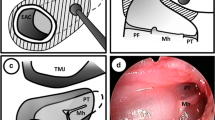Abstract
Anatomical dissection of the human temporal bone is an essential element in the education of ear surgeons. Unfortunately, the acquisition of human temporal bones can be difficult. As an alternative, temporal bones of animals might help. The temporal bones of ten common pigs taken out of a butcher’s daily routine were drilled and dissected under clinical aspects. The resulting anatomy was analyzed and measured. Especially, the mastoid, the external ear canal and the middle ear were incorporated. The preparation was done following a strict order of steps relevant to typical work of an ENT surgeon. Our results were compared with known data of the human temporal bone and effectiveness concerning surgical training was verified. We could see that the temporal bone of the pig had a totally different appearance compared to the human one, especially regarding the length and location of the external ear canal. Also, the mastoid is difficult to identify. It is hidden by the atlanto-occipital joint and has no pneumatization. The anatomical landmarks as the arcades and the facial nerve are congruent to the human anatomy although not all structures are accessible via the mastoid. The pigs’ middle ear showed to be very similar to the human one. The incus showed a shortened long process. This study showed that the temporal bone of the pig might be an alternative regarding some aspects of surgical training in ENT education. A complete replacement is not possible. After some modification, it might be an efficient model for endaural techniques and ossicular manipulation.




Similar content being viewed by others
References
Pracy JP, White A, Mustafa Y, Smith D, Perry ME (1998) The comparatative anatomy of the pig middle ear cavity: a model for middle ear inflammation in the human? J Anat 192:359–368
Seibel VA, Lavinsky L, De Oliveira JA (2006) Morphometric study of the external and middle ear anatomy in sheep: a possible model for ear experiments. Clin Anat 19(6):503–509
Ayres Seibel V, Lavinsky L, Irion K (2006) CT-scan sheep and human inner ear morphometric comparison. Rev Bras Otorrinolaringol 72(3):370–376
Wysocki J (2008) Topographical anatomy and measurements of selected parameters of the rat temporal bone. Folia Morphol (Warsz) 67(2):111–119
Jahnke K (2004) Middle ear surgery. Thieme, New York
Hildmann H, Sudhoff H (2006) Middle ear surgery. Springer, Berlin
Sadé J, Russo E, Fuchs C, Ar A (2006) Acute otitis media and mastoid growth. Acta Otolaryngol 126(10):1036–1039
Zirkle M, Roberson DW, Leuwer R, Dubrowski A (2007) Using a virtual reality temporal bone simulator to assess otolaryngology trainees. Laryngoscope 117(2):258–263
Sewell C, Morris D, Blevins NH, Barbagli F, Salisbury K (2007) Evaluating drilling and suctioning technique in a mastoidectomy simulator. Stud Health Technol Inform 125:427–432
Owa AO, Gbejuade HO, Giddings C (2003) A middle-ear simulator for practicing prosthesis placement for otosclerosis surgery using ward-based materials. J Laryngol Otol 117(6):490–492
Ismail-Koch H, Marshall L, Alabi T, Buckland J (2008) The ear trainer model. Clin Otolaryngol 33(6):635
Freigang B, Motsch Ch, Khvadagiani M, Khvadagiani E (2007) Improvement of the ear-surgery technique applying artificial temporal bones. Georgian Med News Mar(144):27–29
Gocer C, Eryilmaz A, Genc U, Dagli M, Karabulut H, Iriz A (2007) An alternative model for stapedectomy training in residency program: sheep cadaver ear. Eur Arch Otorhinolaryngol 264(12):1409–1412 (Epub 6 Sep 2007)
Trier P, Noe KØ, Sørensen MS, Mosegaard J (2008) The visible ear surgery simulator. Stud Health Technol Inform 132:523–525
Conflict of interest
The authors declare that they have no conflict of interest.
Author information
Authors and Affiliations
Corresponding author
Rights and permissions
About this article
Cite this article
Gurr, A., Kevenhörster, K., Stark, T. et al. The common pig: a possible model for teaching ear surgery. Eur Arch Otorhinolaryngol 267, 213–217 (2010). https://doi.org/10.1007/s00405-009-1040-6
Received:
Accepted:
Published:
Issue Date:
DOI: https://doi.org/10.1007/s00405-009-1040-6



